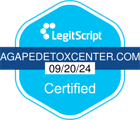Table of Contents
ToggleUnderstanding the Risks and Symptoms
Suboxone has become a widely used treatment for opioid addiction, offering a combination of buprenorphine and naloxone. This medication helps individuals overcome their addiction by satisfying the brain’s need for opioids without inducing the euphoric “high” associated with other opioids. While Suboxone is generally safe when taken as directed, it is essential to be aware of the potential risks of overdose and the symptoms to watch out for. Here we will explore the factors that can contribute to a Suboxone overdose, the drugs that interact with Suboxone and increase the risk, as well as the symptoms and steps to take in the event of an overdose.
Understanding Suboxone and How It Works
Suboxone combines two key components: buprenorphine and naloxone. Buprenorphine, a partial opioid agonist, satisfies the brain’s craving for opioids without producing the intense high associated with full agonists like oxycodone or heroin. This feature is particularly crucial in addiction treatment, as it helps individuals gradually wean off opioids while minimizing withdrawal symptoms.
Naloxone, on the other hand, serves as an antagonist to counteract the potential for misuse. When injecting Suboxone, naloxone binds to the opioid receptors instead of buprenorphine, causing uncomfortable withdrawal symptoms. This mechanism acts as a deterrent against misuse and reduces the risk of overdose.
Factors That Increase the Risk of Suboxone Overdose
While Suboxone is generally safe, certain factors can increase the likelihood of an overdose. Individuals who have never taken opioids before are at a higher risk, as their bodies may be more sensitive to the effects of Suboxone. Furthermore, decreased liver, kidney, or heart function in older individuals can change how their bodies metabolize Suboxone and increase the risk of overdose.
Moreover, mixing Suboxone with certain drugs can amplify its effects and heighten the risk of overdose. Alcohol, benzodiazepines, antidepressants, barbiturates, and cocaine are among the substances that can interact with Suboxone and potentially lead to an overdose. It is essential to exercise caution and consult with a healthcare professional about any potential drug interactions.
Drugs That Interact with Suboxone and Increase Overdose Risk
Several drugs can interact with Suboxone and heighten the risk of overdose. It is crucial to be aware of these interactions and avoid combining Suboxone with the following substances:
- Alcohol
- Benzodiazepines (e.g., clonazepam, diazepam, lorazepam)
- Antidepressants
- Barbiturates
- Cocaine
- Dextromethorphan
- Hormonal contraceptives
- Ketamine
- Methamphetamine
- Opiates (e.g., heroin, hydrocodone)
- PCP
- Phenobarbital and other epilepsy treatments
- Synthetic cannabinoids
When taking Suboxone in combination with any of these substances, the risk of adverse reactions and overdose significantly increases. It is crucial to inform healthcare professionals about any medications or substances you are taking to ensure your safety.
Recognizing the Symptoms of Suboxone Overdose
Being able to recognize the symptoms of a Suboxone overdose is crucial for prompt medical intervention. The symptoms of a Suboxone overdose are similar to those of other opioid overdoses and may include:
- Abdominal pain
- Anxiety, irritability, and mood swings
- Appearing drugged or drunk
- Depressed or shallow breathing
- Difficulty concentrating or poor memory
- Loss of physical coordination
- Nausea and vomiting
- Sleepiness
- Slowed heartbeat
- Seizures
- Coma
- Death
If you suspect someone has overdosed on Suboxone or mixed it with other substances, it is essential to call 911 immediately. Time is of the essence, and seeking emergency medical attention is crucial for the individual’s survival.
Naloxone: An Essential Life Saving Tool
Naloxone, also known as Narcan, is a medication that can temporarily reverse the effects of opioid overdose, including Suboxone. If you have access to naloxone, it is recommended to administer it if a Suboxone overdose occurs. Naloxone works by rapidly binding to the opioid receptors, displacing any opioids present and restoring normal breathing.
However, it is important to note that naloxone’s effects are temporary, and additional medical attention is still necessary. Even if the individual appears to have recovered after naloxone administration, it is crucial to seek immediate medical help to address any underlying issues and ensure their safety.
The Importance of Seeking Emergency Medical Treatment
In the case of a Suboxone overdose, seeking emergency medical treatment is the only way to ensure the individual’s survival. Even though buprenorphine has a ceiling effect that minimizes the risk of overdose when taken as directed, certain circumstances can still lead to dangerous situations. Prompt medical intervention can provide the necessary support and treatment to prevent severe complications.
If you or someone you know is struggling with opioid addiction and considering Suboxone as a treatment option, Agape Detox Center can provide you with a healthcare professional who can guide you through the process, monitor your progress, and address any concerns or questions you may have.
Suboxone Addiction Treatment
Suboxone is a valuable medication in the treatment of opioid addiction, offering a safer alternative to full agonists while helping individuals manage withdrawal symptoms. However, it is important to understand the potential risks of overdose and the factors that can increase that risk.
By being aware of the drugs that interact with Suboxone and recognizing the symptoms of an overdose, we can take steps to prevent and address potentially life-threatening situations. Remember, seeking emergency medical treatment is essential in the event of a Suboxone overdose.

Stephanie Robilio is an accomplished Clinical Director at Agape Behavioral Healthcare. With a Master of Social Work degree, LCSW license, and extensive training in Rapid Resolution Therapy under her belt, she brings a wealth of expertise to her role. Her unique combination of education and experience allows her to provide exceptional care to clients and lead her team with confidence. Stephanie’s joy comes from witnessing the moments when her patients creatively connect the dots and bravely move toward reclaiming their power. Her purpose is to help individuals understand their past so they can create a future full of hope, growth, and success. Stephanie attributes a large portion of her success to the supportive culture and strong sense of community fostered by the Agape team.





